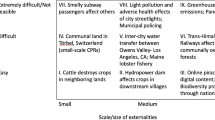Abstract
We investigate the location choice of two firms whose objectives are the weighted average of their own profit and social welfare, in which they simultaneously decide their locations before setting their prices. The purpose of this paper is to examine whether the asymmetric locations are influenced by the asymmetry of the firms’ objectives or by the asymmetry of firms’ marginal costs. We show that, when both firms have the same marginal cost, the equilibrium locations are always symmetric even in the case of the asymmetric objectives. On the other hand, the cost differences lead the asymmetric locations in equilibrium. That is, the asymmetric locations are a result of the cost asymmetry, but not the asymmetry of the firms’ objectives. We also demonstrate that the pursuit of profit by the cost-inefficient firm may increase consumer surplus.
Similar content being viewed by others
References
Cremer H, Marchand M, Thisse JF (1991) Mixed oligopoly with differentiated products. Int J Ind Organ 9(1):43–53
d’Aspremont C, Gabszewicz JJ, Thisse JF (1979) On hotelling’s stability in competition. Econometrica 47(5):1145–1150
Ghosh A, Mitra M (2014) Reversal of bertrand-cournot rankings in the presence of welfare concerns. J Inst Theor Econ 170(3):496–519
Hino Y, Zennyo Y (2015) Corporate social responsibility and strategic relationships. MPRA paper No. 67950
Kitahara M, Matsumura T (2013) Mixed duopoly, product differentiation and competition. Manch Sch 81(5):730–744
Lu Y, Poddar S (2007) Firm ownership, product differentiation and welfare. Manch Sch 75(2):210–217
Matsumura T (1998) Partial privatization in mixed duopoly. J Public Econ 70(3):473–483
Matsumura T, Matsushima N (2004) Endogenous cost differentials between public and private enterprises: a mixed duopoly approach. Economica 71(284):671–688
Matsumura T, Ogawa A (2014) Corporate social responsibility or payoff asymmetry? a study of an endogenous timing game. South Econ J 81(2):457–473
Matsumura T, Shimizu D (2010) Privatization waves. Manch Sch 78(6):609–625
Tabuchi T, Thisse JF (1995) Asymmetric equilibria in spatial competition. Int J Ind Organ 13(2):213–227
Acknowledgments
I would like to thank the editor, Kenji Matsui, Toshihiro Matsumura, Noriaki Matsushima, Keizo Mizuno, and seminar participants at Sapporo Gakuin University for their very helpful and constructive comments on an earlier version of my paper. Responsibility for all remaining errors lies solely with the authors. The research for this study was supported by a Grant-in-Aid for JSPS Fellows no. 12J03397 and a Grant-in-Aid for young scientists (B) 16K17126 from the Japan Society for the Promotion of Science and the Ministry of Education, Culture, Sports, Science and Technology of the Japanese Government.
Author information
Authors and Affiliations
Corresponding author
Appendix
Appendix
Proof of Proposition 1
If both firms maximize social welfare ( α 1 = α 2=0), it is well known that the social optimal location (\(\phantom {\dot {i}\!}l_{i}^{\ast }=1/4\)) is achieved, in equilibrium. We analyze the equilibrium locations for the rest of the parameter space below. The first-order condition with respect to the location l i is given by:
In the case of \(\phantom {\dot {i}\!}\hat x_{i} >0\), it is easy to show that A i >0. Therefore, the equilibrium locations \(\phantom {\dot {i}\!}(l_{1}^{\ast },l_{2}^{\ast })\) have to satisfy the following system of equations:
Solving these for the firms’ locations yields the following symmetric equilibrium:
□
Proof of Proposition 2
Differentiating \(\phantom {\dot {i}\!}l_{i}^{\ast }\) and \(\phantom {\dot {i}\!}l_{j}^{\ast }\) with respect to α i yields:
In the case of the same marginal cost, c i = c j , it is easy to see that \(\partial l_{i}^{\ast } / \partial \alpha _{i} < 0\) and \(\partial l_{j}^{\ast } / \partial \alpha _{i} < 0\). When firm i has a smaller marginal cost, c i <c j , it can be shown that \(\phantom {\dot {i}\!}\partial l_{i}^{\ast } / \partial \alpha _{i} < 0\). The sign of \(\partial l_{j}^{\ast } / \partial \alpha _{i}\) is as follows:
Furthermore, in the case of c i > c j , it can be similarly proved that \(\phantom {\dot {i}\!}\partial l_{i}^{\ast } / \partial \alpha _{i} < 0\) and \(\phantom {\dot {i}\!}\partial l_{j}^{\ast } / \partial \alpha _{i} < 0\). □
Proof of Proposition 3
□
Proof of Proposition 4
First, it can be shown as follows that both firms increase their prices as the cost-efficient firm puts a greater weight on its own profit.
Next, we can derive the following results regarding the signs of the derivatives of prices with respect to the weight the cost-inefficient firm puts on its profit:
Finally, we summarize these results as follows:
□
Proof of Proposition 5
Suppose that firm i is more efficient than firm j, c i <c j . The derivatives of the equilibrium demands with respect to the parameter α i and α j are given by:
□
Proof of Proposition 6
Suppose that firm i is more efficient than firm j, c i <c j . The derivative of \(\pi _{i}^{\ast } = (p_{i}^{\ast } -c_{i}) x_{i}^{\ast }\) with respect to the parameter α i is given by:
It is easy to see that N i i >0, which in turn provides \(\phantom {\dot {i}\!}\partial \pi _{i}^{\ast } / \partial \alpha _{i} >0\). Similarly, the derivative of \(\phantom {\dot {i}\!}\pi _{j}^{\ast }\) with respect to the parameter α i is given by:
As N j i is increasing in t and \(\phantom {\dot {i}\!}t> \underline t\), it can be shown that \(N_{ji} > N_{ji}|_{t= \underline t}=64(c_{j}-c_{i})^{2}\alpha _{i} \alpha _{j} (1-\alpha _{j})(\alpha _{i}+\alpha _{j}-\alpha _{i} \alpha _{j})^{3} \geq 0\). Thus, we can show that \(\phantom {\dot {i}\!}\partial \pi _{j}^{\ast } / \partial \alpha _{i} > 0\). □
Proof of Proposition 7
The partial derivative of the equilibrium consumer surplus with respect to α i is given by:
It is easy to show that, when firm i is more efficient ( c i <c j ), the right-hand-side of Eq. (1) becomes negative. Similarly, we can derive the partial derivative of the equilibrium consumer surplus with respect to α j as follows:
The partial derivative of Eq. (2) yields that ∂ C S ∗/∂ α j is a decreasing function in the parameter \(\phantom {\dot {i}\!}t \in ( \underline t, \infty )\) as follows:
We can additionally show the following two inequalities.
Therefore, we can prove that there exists a threshold \(\phantom {\dot {i}\!}\hat t\) such that the consumer surplus is increasing in the parameter α j at the range of \(\phantom {\dot {i}\!}t \in (\underline t, \hat t~]\), and is decreasing in the parameter α j at the range of \(\phantom {\dot {i}\!}t \in [\hat t, \infty )\). □
Proof of Proposition 8
The partial derivative of the equilibrium social welfare with respect to α i is given by:
□
Rights and permissions
About this article
Cite this article
Zennyo, Y. Asymmetric Payoffs and Spatial Competition. J Ind Compet Trade 17, 29–41 (2017). https://doi.org/10.1007/s10842-016-0229-9
Received:
Accepted:
Published:
Issue Date:
DOI: https://doi.org/10.1007/s10842-016-0229-9




